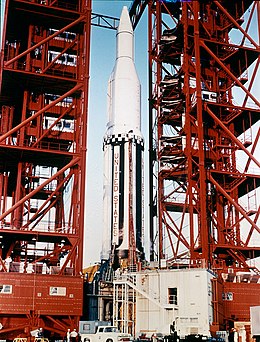Saturn I SA-2

SA-2 sitting on Pad 34 with service structure
|
|
| Mission type | Test flight |
|---|---|
| Operator | NASA |
| Mission duration | 2 minutes, 40 seconds |
| Distance travelled | 80 km (50 mi) |
| Apogee | 105.3 km (65.4 mi) |
| Spacecraft properties | |
| Launch mass | 420,000 kg (463 short tons) |
| Start of mission | |
| Launch date | April 25, 1962, 14:00:34 UTC |
| Rocket | Saturn I SA-2 |
| Launch site | Cape Canaveral LC-34 |
| End of mission | |
| Destroyed |
April 25, 1962, 14:03:14 UTC (Project Highwater) |
|
Project Apollo
Unmanned tests |
|
Saturn-Apollo 2 (SA-2) was the second flight of the Saturn I launch vehicle, the first flight of Project Highwater, and was part of the American Apollo program. The rocket was launched on April 25, 1962, from Cape Canaveral, Florida.
Launch preparation for the mission began at Cape Canaveral on February 27, 1962, with the arrival of the second Saturn I launch vehicle. The only significant change made to the vehicle from the previous SA-1 flight was the addition of extra baffles in the propellant tanks to prevent fuel sloshing. While no serious delays were encountered, there were several minor problems reported.
A leak was detected between the liquid oxygen dome and injector for the #4 H-1 rocket engine; while attempts were made to fix the problem, it was eventually decided to launch without replacing the engine. Minor problems were found in the guidance subsystem and service structure operations, damaged strain gauges were found in a liquid oxygen stud and truss member, and a manhole cover on the dummy Centaur (S-V-D) third stage had to be replaced. Problems arose with two of the fueling computers, but each was repaired. Three hydraulic systems were also listed as potential problems.
Despite the issues encountered during flight preparation, none required the target launch date of April 25 to be pushed back.
Saturn-Apollo 2 was launched at 14:00:34 UTC on April 25, 1962, from Launch Complex 34. The only hold in the countdown sequence was for 30 minutes due to a vessel which entered the flight safety zone 60 miles (96 km) down range. The rocket carried 619,000 pounds (281,000 kg) of propellant, about 83% of its maximum capacity.
...
Wikipedia

